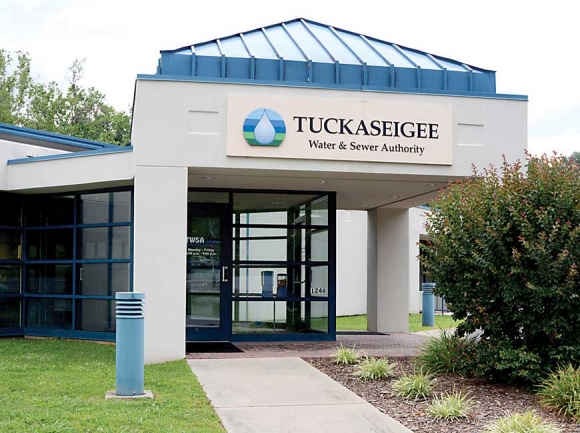New sewer capacity could soon come to Cashiers
 TWSA will discuss a policy to release the remaining 20,000 gallons of capacity at its Cashiers plant during its March meetings, including a work session March 13 and business meeting March 20. Holly Kays photo
TWSA will discuss a policy to release the remaining 20,000 gallons of capacity at its Cashiers plant during its March meetings, including a work session March 13 and business meeting March 20. Holly Kays photo
A new sewer treatment plant being planned for Cashiers will start allowing for growth in the mountain community before the first shovelful of dirt is turned on the project.
Currently, 90 percent of the existing treatment plant’s capacity has been allocated to various users, and the state requires that the Tuckaseigee Water and Sewer Authority hold the remaining 10 percent in reserve for emergencies, such as failing septic systems.
However, as plans for the new treatment plant move forward the state will let TWSA release that remaining 10 percent, a total capacity of 20,000 gallons per day.
“What we’re trying to do now that we have this funding from the USDA (U.S. Department of Agriculture) is to say, ‘How can we release the last 10 percent, the last 20,000 gallons?’” Dan Harbaugh, executive director of TWSA, told the TWSA board during a Feb. 13 meeting.
He’s already been getting calls from various business owners wanting to grab hold of some of that soon-to-be-available capacity, and he’s telling them all the same thing: TWSA won’t take applications for the upcoming capacity until after its board finalizes the process for releasing it. That’s expected to happen during a meeting at 5:30 p.m. Tuesday, March 20.
“There are projects already that will begin to come back to us as we look at releasing allocation of that 20,000 gallons,” Harbaugh told the board.
Related Items
The largest of these requests is coming from the High Hampton Inn, which wants to build 100 units of workforce housing requiring 12,000 gallons per day — as a first phase. At some point in the future, Harbaugh said, the inn will want to build an additional 100 units.
He’s also received requests from the Village Green and the Chattooga Club for expansion projects and from a restaurant requesting 3,000 gallons per day.
In addition to the 20,000 gallons likely to become available in March, once plans for the new plant are complete, TWSA can begin “preselling” allocation at the new plant. Users who want allocation once the new plant comes online would be able to reserve it, with that allocation becoming available upon completion of the plant, likely in late 2020 or early 2021.
The existing treatment plant has been near capacity for years — on paper. During the real estate boom of the early 2000s, many developers bought up significant amounts of sewer allocation to be used on homes that were never built following the stock market crash of 2008. They’ve held onto that allocation in hopes that the market will rebound and their investment will ultimately prove lucrative, but a side effect has been that — while the plant is certainly not processing at capacity — there’s no allocation available for folks wanting to start a new business or build a new house.
It’s a situation that’s effectively put a hold on economic development in Cashiers. No new sewer capacity means no new housing, retail and restaurants, and no way to expand existing establishments.
“If you talk to the locals in that area and the people who run businesses up there, one of the main impediments is the ability to hire staff and manage for the needs of the community in the various businesses out there,” Harbaugh said.
Eventually, that all comes back to sewer.
The new sewer plant will be built on a 16-acre property TWSA purchased along the Horsepasture River in 2015. The initial phase of construction will cost $9.5 million and result in a sewer plant with a capacity of 125,000 gallons per day. The existing 200,0000-gallon-per-day plant will remain online, and two additional construction phases are in the long-range plan for the new plant — the next one is tentatively planned for 10 years from now.
Board members were glad to hear that some sewer capacity would become available even before construction begins but questioned whether there might be a way to open it up even more. If certain large-capacity allocation holders were certain they weren’t going to cash in their allocation for, say, the next three years, couldn’t TWSA just go ahead and release that amount at the existing plant?
“Can’t we have an agreement with them saying they’re going to loan it to us and we’ll give it back to them?” asked Tom Sawyer, a member of the board.
Not possible, said Harbaugh.
“We’d be taking their allocation and selling it to someone else, which would mean we’re double-allocating,” he said.
But TWSA can be sure it will soon have 20,000 gallons to work with, and there will be plenty of knotty questions to work out surrounding that availability, Harbaugh said.
It will be up to the TWSA board to settle on a policy for giving out the 20,000 gallons. Should the allocation be released first-come, first-served? Should a certain amount be designated for commercial use and a certain amount for residential? Should some other approach be used?
“This is not a simple issue. It’s a complex issue,” Harbaugh told the board.
There’s also the time element. The board will ultimately need to make the decision, distilling all the information and opinions at play into a cohesive policy. That can take time, but for many of those seeking a piece of the 20,000 gallons, time is of the essence.
“The only thing is being pushed because of others’ needs,” Tracy Rodes, a member of the TWSA board and mayor of Webster, said during the Feb. 13 discussion. “We are responsible for writing good policies, and that is our main job — not to rush and getting ourselves in a bind.”
The TWSA board plans to consider policies to release capacity during its March meetings, which include a work session Tuesday, March 13, and a business meeting Tuesday, March 20. Both meetings occur 5:30 p.m. at the TWSA headquarters in Sylva.









